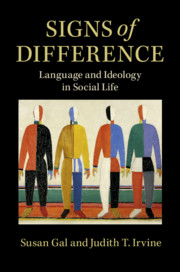Book contents
- Signs of Difference
- Signs of Difference
- Copyright page
- Contents
- Figures
- Tables
- Acknowledgments
- Introduction
- Part I Ethnography
- Part II Semiotics
- 3 Ingredients: Signs, Conjectures, Perspectives
- 4 Comparison: The Semiotics of Differentiation
- 5 Dynamics of Change in Differentiation
- Part III Sites
- Part IV Pasts
- Notes
- References
- Index
3 - Ingredients: Signs, Conjectures, Perspectives
from Part II - Semiotics
Published online by Cambridge University Press: 17 June 2019
- Signs of Difference
- Signs of Difference
- Copyright page
- Contents
- Figures
- Tables
- Acknowledgments
- Introduction
- Part I Ethnography
- Part II Semiotics
- 3 Ingredients: Signs, Conjectures, Perspectives
- 4 Comparison: The Semiotics of Differentiation
- 5 Dynamics of Change in Differentiation
- Part III Sites
- Part IV Pasts
- Notes
- References
- Index
Summary
Using thought experiments, the chapter shows how semiotic process constitutes the basics of ideology. Drawing on works of Charles Sanders Peirce and Nelson Goodman, it uses everyday terms to show how signs are defined by the conjectures that people make. People’s presuppositions about the world allow them to guess what can be taken as a sign, connecting signs to objects they are conjectured to represent. Thus, people construct sign relations and achieve meanings. This work of conjecturing is then erased and signs seem to stand by themselves. Sign making is open-ended; new conjectures are metasemiosis, building on and revising earlier ones. The chapter explains typification in sign making and the difference between signs as icons, depicting what they represent, indexes pointing to what they represent, and symbols that rely on a code. These kinds of sign relations are intertwined. Special attention is given to linguistic signs and Silverstein’s metapragmatics as a context-creating level of analysis. Finally, a brief American narrative is analyzed showing how the writer reasons with signs to metasemiotically create her perspective and make sense of her surroundings.
- Type
- Chapter
- Information
- Signs of DifferenceLanguage and Ideology in Social Life, pp. 87 - 111Publisher: Cambridge University PressPrint publication year: 2019



